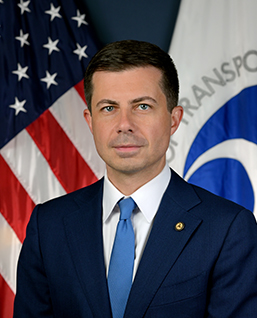Traffic deaths across the United States appear to be leveling off after a spike during the pandemic, U.S. Transportation Secretary Pete Buttigieg told safety officials in Washington, D.C., Thursday.
But rather than celebrate, Buttigieg said, officials should use that as an opportunity to continue driving down largely preventable deaths in the future.
“We’re really beginning to see the recent rise level off a bit,” Buttigieg said during the opening of the conference, which was livestreamed for reporters across the country. “What’s really giving it life is the commitment you have made.”
The one-day conference in Department of Transportation headquarters was a follow-up to Buttigieg’s call in January 2022 for a National Roadway Safety Strategy to reduce traffic deaths that surged on open roads during the pandemic after nearly a decade of reductions. More than 150 safety officials and organizations from across the country attended to share ideas that have worked in their communities.
Figures in April from the National Highway Transportation Safety Administration estimated that deaths fell 0.35% in 2022 after more than two years of increases. That included the second quarter of 2021, when deaths rose more than 20% above the previous year for the highest increase since the agency began collecting data in 1975.
Last year, Buttigieg announced a five-pronged strategy to deal with traffic deaths: teaching people to be safer drivers, building safer roads, improving vehicle safety, driving at safer speeds and improving medical care for crash victims. The department earmarked $14 billion in federal stimulus funds for safety programs.
Thursday, Buttigieg repeated a common refrain that Americans need to change their acceptance of traffic deaths as a normal part of society. Europeans have far fewer traffic deaths, he said, and U.S. cities such as Hoboken and Jersey City have been successful in reaching their goal of zero deaths, four years in a row for Hoboken.
“We need to learn from those places,” Buttigieg said. “I believe that shift [away from accepting traffic deaths] is underway.”
During a brief panel discussion, the department’s five deputy administrators pointed to actions that should improve safety. For example, the Federal Highway Administration noted it has awarded more than $800 million of the $5 billion in stimulus funds earmarked for the Safe Streets and Roads for All program and the NHTSA proposed Wednesday requiring cars and light trucks to have automatic emergency braking systems, which it estimated would save 360 lives and eliminate more than 24,000 injuries each year.
“I think the cultural change is here,” said Andrew Rogers, deputy administrator at FHWA. “It’s up to us and the people in this room to make sure [stimulus funds] are used to their best advantage.”
Related story: Officials say $20 million grant can help lower the death toll on the nation’s roads
Ed covers transportation at the Pittsburgh Post-Gazette, but he's currently on strike. Email him at eblazina@unionprogress.com.



